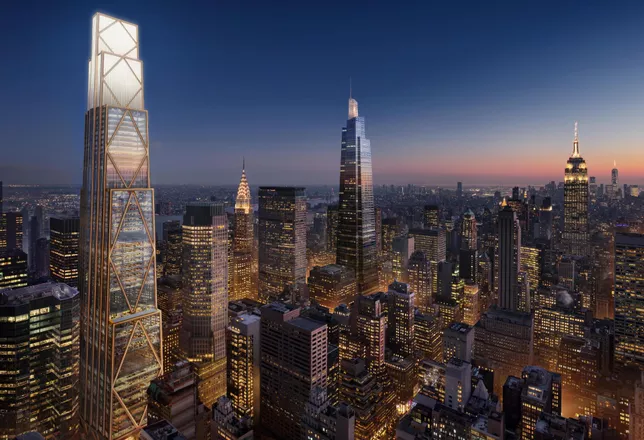JPMorgan Chase’s global headquarters will be New York City's largest all-electric tower, according to plans for the new 60-story, 1,388-foot skyscraper the bank released Thursday.
The building at 270 Park Ave. will have "net zero operational emissions and will be 100% powered by renewable energy," when it opens, which is expected to be in 2025, according to a press release.
Built as part of the Midtown East rezoning, the new tower is being developed on the site of the bank's old headquarters, the former Union Carbide building that, at 52 stories and 707 feet, is believed to have been the largest voluntary demolition in history.
The new 270 Park will house 14,000 workers and aims to set a new bar on workplace wellness and sustainability, according to the release. Water storage and reuse systems are set to reduce the tower’s water usage by 40%, and the bank said 97% of the materials from the demolition will be upcycled in the new skyscraper.
According to a study by Architecture 2030, using figures from the U.N. and the U.S. Energy Information Administration, 75% of the carbon emitted during a building’s life cycle comes from its construction and demolition, and just 25% from its operations.
“With our new headquarters, JPMorgan Chase is making a long-term investment in our business and New York City’s future while ensuring that we operate in a highly efficient and world-class environment for the 21st century,” JPMorgan CEO Jamie Dimon said. “We are extremely excited about the building’s state-of-the-art technology, health and wellness amenities, and public spaces, among many other features. It is in the best location in one of the world’s greatest cities.”
After repeated comments advocating for full-time office work, Dimon recently conceded that remote work will be a major part of American businesses, and predicted in an annual shareholder letter that half of the company's employees will be at their desks all the time. The bank is currently the city’s largest private office tenant.

This new, 2.5M SF building will feature 50% more communal spaces and 25% more space per person, according to the release. It will also pump in double the amount of fresh air as a typical office building, and will use “advanced HVAC filtration systems” to clean outdoor air and recirculated air.
The company had already said it will go with a flexible design for its new building, with the plans able to be shifted into different setups. Now, it says it will bring in 30% more daylight than a typical speculative office building and will be making use of circadian lighting. The company is partnering with the likes of Dr. Deepak Chopra and Union Square’s Danny Meyer for its wellness and hospitality offerings.
The company announced back in 2018 that it planned to replace its existing 52-story building at 270 Park Ave. to make use of the Midtown East rezoning. Demolition work began in 2019, and the New York City Council approved plans that would involve 10K SF of public space at the base of the building.
In total, the bank said it will offer two-and-a-half times more outdoor space on the ground level of Park and Madison avenues, as well as wider sidewalks and a large public plaza on Madison Avenue. JPMorgan has committed to what it calls a “significant investment” to help improve the city’s infrastructure and transit system.
It is not the only company committing to renewable energy. Brookfield said last month it is going to power its skyscraper One Manhattan West with electricity generated by hydropower facilities owned by Brookfield Renewables. JPMorgan, which this week announced a 42% year-over-year profit decline thanks in part to market turbulence caused by the conflict in Ukraine, is also rolling out a new energy-saving technology across a large chunk of its portfolio, Bisnow first reported.
The Nantum operating system, developed by Prescriptive Data, will be in place in around 30M SF of JPMorgan’s space by the end of 2022. The system uses artificial intelligence to more effectively monitor various building systems, including occupancy, air quality and temperature and reduce energy consumption where it is not needed.

No comments:
Post a Comment